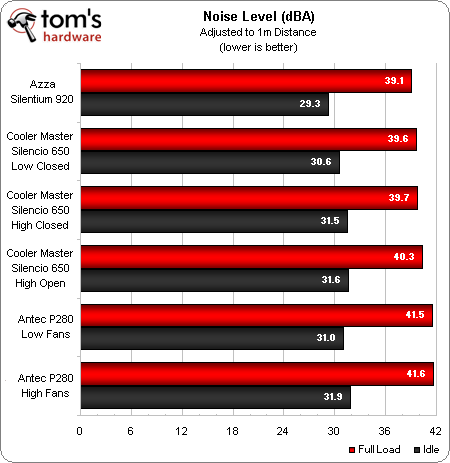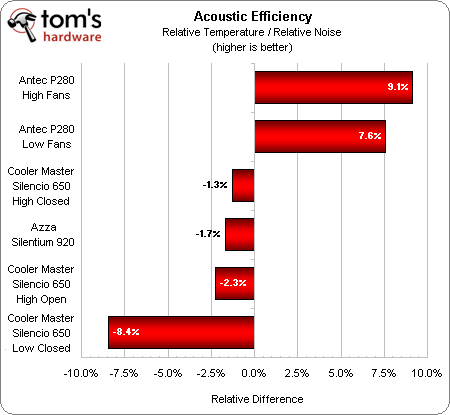Quiet Gaming Cases, Part 1: Antec, Azza, And Cooler Master
The pursuit of performance often dictates that we simply live with a loud PC. Enthusiasts sometimes feel forced to choose between reasonable acoustics and the ventilation needed to overclock. Today, we evaluate three cases that promise to deliver both.
Heat, Noise, And Heat Versus Noise
Antec has a two-speed fan controller, while Cooler Master has an analog controller plus a closeable top-panel vent. We tested the P280 at both fan speeds and the Silencio 650 at maximum and minimum fan speed. We then opened the vent on the Silencio 650 to see if it would help or hinder CPU temperature.
Primarily a gaming case, but with added noise-reducing features, the P280 has the lowest internal temperatures of the first three cases in today’s test. Cooler Master’s Silencio 650 takes second place in this test, though opening the vent without adding a fan there has little effect on overall temperature.
Antec’s P280 also has an open top with two noise-generating fans. Although we measure noise from 45° off of the front panel, noises that emanate from elsewhere still affect the measurement via dispersion. Azza scores best here, with Cooler Master in second place, so long as its top vent is closed.
The first step in comparing temperature to noise is to make a lower temperature result in a higher score. We averaged the temperature reading of all cases, and divided that number by each case’s average temperature to produce an inverse, percentage-based thermal performance scale. Each case’s average noise level is then divided by the average for all cases, creating a direct percentage-based acoustic performance scale.
The term “Relative” in the Acoustic Efficiency chart refers to how each case relates, on a percentage scale, to the class average of 100%. Efficiencies greater than 100% are impossible, so we simply move the average to 0% by subtracting the integer one from each result.
Antec’s P280 has a maximum 9.1% greater-than-average cooling-to-noise ratio, but is its noise level even low enough to qualify for a quiet computing article? While it's far from silent, the noise level at full load is below the 42 dB(A) cited by New York City as the minimum to qualify as noise pollution, while its idle (not gaming) noise level is below the 35 dB(A) constant noise cited by the WHO as a general annoyance for humans. In other words, the P280 is barely quiet enough to make our test configuration acceptable to ordinary folks.
Get Tom's Hardware's best news and in-depth reviews, straight to your inbox.
Current page: Heat, Noise, And Heat Versus Noise
Prev Page Test Settings Next Page Quiet Cases: Do We Have A Winner Yet?-
jrayx I like the Silencio 650 features, but the airflow is restricted in the front and bottom. And no one sells that case in my country.Reply -
dthesleepless I'd like to see how the Nanoxia Deep Silence 1 compares in your testing.Reply
In my testing I found it to be the most efficient silent case I've ever had on my workbench. -
EzioAs Things I love about silence optimized case: Simple, elegant look. Nothing tacky and doesn't looks like it was made for some 12 years oldReply
Things I hate about silence optimized case: Usually doesn't cool well (poor airflow) and isn't really that much quieter compared to non silence optimized case
It 's really hard to find the right balance but I'm loving the Antec P280. Exterior and interior looks good and seems spacious enough. Price isn't so bad either.
Any chance you could review the Nanoxia Deep Silence 1? Heard a lot of good things about it . -
JOSHSKORN I'd like to see the Fractal Design Define R4 (and/or XL if it's not out of stock, which it currently is) reviewed and compared at some point. It's suppose to be a quiet case. Gaming, not sure about that one.Reply -
killerclick As usual, Cooler Master is mediocre at best. What pathetic company, the only thing they seem to do good is marketing to budget-conscious consumers.Reply -
EzioAs Reply9540164 said:As usual, Cooler Master is mediocre at best. What pathetic company, the only thing they seem to do good is marketing to budget-conscious consumers.
I disagree. A lot of their chassis are good (HAF, Elite). I like their storm stryker/trooper. Most of their peripherals have great quality and reasonable price compared to something like Razer. Their coolers are also great as well (Hyper 212/212+/212 EVO). I just find their power supply unit to be the 2nd grade components, almost all of them I wouldn't use or recommend to other people -
mayankleoboy1 ^ except for the high-end cooler master PSU's. They are quite decent, probably because Seasonic actually makes them.Reply -
Crashman dthesleeplessI'd like to see how the Nanoxia Deep Silence 1 compares in your testing.In my testing I found it to be the most efficient silent case I've ever had on my workbench.JOSHSKORNI'd like to see the Fractal Design Define R4 (and/or XL if it's not out of stock, which it currently is) reviewed and compared at some point. It's suppose to be a quiet case. Gaming, not sure about that one.Perhaps you will...has anybody ever noticed the resemblance between those two?Reply



